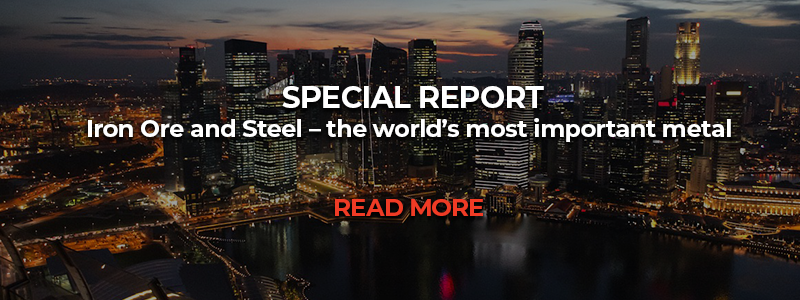Iron Ore Price hits $100 for the first time since 2014 – The Iron Ore Industry and ‘Kairos’
There are few fundamental truths that seem to continue to endure, within a world in an ever changing state of flux, one which seems to change further with each morning tide. Yet, since the 1850’s, when British engineer Henry Bessemer first developed an inexpensive manner of mass producing Steel, Iron Ore and Steel have become and remained fundamental to modern day production and construction for over a century and a half, with no signs of slowing down.
There are few fundamental truths that seem to continue to endure, within a world in an ever changing state of flux, one which seems to change further with each morning tide. Yet, since the 1850’s, when British engineer Henry Bessemer first developed an inexpensive manner of mass producing Steel, Iron Ore and Steel have become and remained fundamental to modern day production and construction for over a century and a half, with no signs of slowing down.
Steel is used in our buildings, our cars, our computers and appliances and in numbered forms of infrastructure. As global population grows and our methods for inhabiting the world changes (with more and more cities being forced to adapt to methods of growing “up, not out” due to the limitations of Urban Sprawl), steel and iron are being relied on more than ever.
Ancient Greek architecture may have favoured stone over steel, however, and as ever, we can continue to look to the Greeks for their ruminations and concepts. They invented the ancient rhetorical concept of ‘Kairos’, a theory which has gained further importance over the centuries and is the perfect definition of the inflection point at which the Iron Ore industry finds itself. At best translation, Kairos is “timeliness, appropriateness, symmetry, balance” and “the circumstances that open moments of opportunity.”
The reason we speak to ‘timeliness’ and ‘opportunity’ are a unique chain of events that have led to an interesting moment in time for this crucial resource. The Vale disaster in January has had a devastating human effect, but also caused further supply chain issues. A cumulative 225 million tonne Iron-Ore supply deficit is expected for 2019-2021 (around $22.5 billion at the current Iron Ore Price).
This supply deficit means the next 3 years are a big deal for Iron Ore Companies. Since January 31st till day of publishing (12 June), the Iron Ore price has risen an astronomical 35.16% from $76.03UD to $102.73USD. The iron Ore price raised its head above $100 for the first time since 2014 in late May, with forecasters suggesting it may go even higher. Only a handful of iron ore companies have the capacity to fill the continuing void, and bustling economies such as India and China simply do not produce enough steel to meet their own demand.
China is notably one of the fastest growing economies in the world and is by far the largest consumer of raw materials such as steel. It consumes almost 50% of global steel, and despite bearish talks and the unpredictability of the US-China trade conflict, its economy continues to expand, currently at around 14 trillion USD and growing, adding 1 trillion USD a year.
One of the most important aspects of Chinese growth is the expanding middle class and consumer growth. Since the liberalisation of the Communist State, commerce has exploded along with rapid urbanisation. Since 2000, 350 million people have migrated to the cities and 60% of the Chinese population now lives in cities. 20 million people move into paid work each year, giving them a larger income to buy houses, cars and appliances – all of which need steel.
However, domestic iron ore production in China has dramatically declined around 50% from highs in 2014 as the iron ore price fell. Local iron production is expensive and does not have the capacity to meet demand.
Other global economies have a similar story. India would like to be producing 300mtpa of crude steel by 2030, but 60% of this will probably need to be imported. South Korea and Vietnam also have a growing demand as their economies grow.
Australia’s miners, such as Carpentaria Resources (ASX: CAP) could be the answer to the supply squeeze. Carpentaria’s Hawsons Iron Project provides the world’s best iron ore product at 70% Fe. With their world’s first Supergrade Iron Ore, Carpentaria Resources are one of the world’s leading underdeveloped projects.
With access to existing infrastructure and fresh international investment, the project is at the optimal time and place to profit, with Carpentaria’s pre-feasibility study identifying a capacity to produce 10 million tonnes per annum, for Hawsons’ 20 year mine life.
The weekly price of iron ore continues to push higher and has likely not peaked yet, and this is an unprecedented moment of Kairos for the industry, hopefully for the economy and for Australian miners such as Carpentaria.

Carpentaria Resources trades under the ASX code: ‘CAP’
*Reach Markets have been engaged by CAP to assist with private investor management.
General Advice Warning
Any advice provided by Reach Markets including on its website and by its representatives is general advice only and does not consider your objectives, financial situation or needs, and you should consider whether it's appropriate for you. This might mean that you need to seek personal advice from a representative authorised to provide personal advice. If you are thinking about acquiring a financial product, you should consider our Financial Services Guide (FSG) including the Privacy Statement and any relevant Product Disclosure Statement or Prospectus (if one is available) to understand the features, risks and returns associated with the investment.
Please click here to read our full warning.
